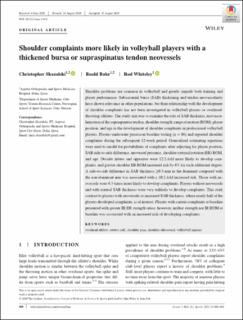| dc.contributor.author | Skazalski, Christopher | |
| dc.contributor.author | Bahr, Roald | |
| dc.contributor.author | Whiteley, Rod | |
| dc.date.accessioned | 2021-02-02T10:53:16Z | |
| dc.date.available | 2021-02-02T10:53:16Z | |
| dc.date.created | 2020-11-11T10:26:35Z | |
| dc.date.issued | 2020 | |
| dc.identifier.citation | Scandinavian Journal of Medicine & Science in Sports. 2020, 31(2), 480-488. | en_US |
| dc.identifier.issn | 0905-7188 | |
| dc.identifier.uri | https://hdl.handle.net/11250/2725765 | |
| dc.description | This is an open access article under the terms of the Creative Commons Attribution License, which permits use, distribution and reproduction in any medium, provided the original work is properly cited. | en_US |
| dc.description.abstract | Shoulder problems are common in volleyball and greatly impede both training and player performance. Subacromial bursa (SAB) thickening and tendon neovascularity have shown relevance in other populations, but their relationship with the development of shoulder complaints has not been investigated in volleyball players or overhead‐throwing athletes. The study aim was to examine the role of SAB thickness, neovascularization of the supraspinatus tendon, shoulder strength, range of motion (ROM), player position, and age in the development of shoulder complaints in professional volleyball players. Players underwent preseason baseline testing (n = 86) and reported shoulder complaints during the subsequent 12‐week period. Generalized estimating equations were used to model for probabilities of complaints after adjusting for player position, SAB side‐to‐side difference, neovessel presence, shoulder external rotation (ER) ROM, and age. Outside hitters and opposites were 12.2‐fold more likely to develop complaints, and greater shoulder ER ROM increased risk by 8% for each additional degree. A side‐to‐side difference in SAB thickness ≥0.3 mm in the dominant compared with the non‐dominant arm was associated with a 10.2‐fold increased risk. Those with neovessels were 6.5 times more likely to develop complaints. Players without neovessels and with normal SAB thickness were very unlikely to develop complaints. This stark contrast to players with neovessels or increased SAB thickness, where nearly half of the players developed complaints, is of interest. Players with current complaints at baseline presented with greater IR:ER strength ratios; however, neither strength nor IR ROM at baseline was associated with an increased risk of developing complaints. | en_US |
| dc.language.iso | eng | en_US |
| dc.subject | overhead athlete | en_US |
| dc.subject | rotator cuff | en_US |
| dc.subject | shoulder pain | en_US |
| dc.subject | shoulder ultrasound | en_US |
| dc.subject | volleyball injuries | en_US |
| dc.title | Shoulder complaints more likely in volleyball players with a thickened bursa or supraspinatus tendon neovessels | en_US |
| dc.type | Peer reviewed | en_US |
| dc.type | Journal article | en_US |
| dc.description.version | publishedVersion | en_US |
| dc.rights.holder | © 2020 The Authors | en_US |
| dc.source.pagenumber | 480-488 | en_US |
| dc.source.volume | 31 | en_US |
| dc.source.journal | Scandinavian Journal of Medicine & Science in Sports | en_US |
| dc.source.issue | 2 | en_US |
| dc.identifier.doi | 10.1111/sms.13831 | |
| dc.identifier.cristin | 1846828 | |
| dc.description.localcode | Institutt for idrettsmedisinske fag / Department of Sports Medicine | en_US |
| cristin.ispublished | true | |
| cristin.fulltext | original | |
| cristin.qualitycode | 2 | |
